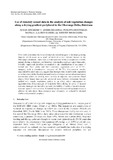Use of remotely sensed data in the analysis of soil-vegetation changes along a drying gradient peripheral to the Okavango Delta, Botswana
Date
2005-10-10Author
Ringrose, S.
Jellema, A.
Huntsman-Mapila, P.
Baker, L.
Brubaker, K.
Publisher
Taylor & Francis; http://www.tandf.co.uk/journals/titles/01431161.aspType
ArticleMetadata
Show full item recordAbstract
This work determines the value of remotely sensed imagery in developing drying impacts which occur as a result of internal and/or external factors in the Okavango catchment. Three sites provide a preview of the consequences of Delta margin drying as depicted over historical, intermediate and geological timescales. Initially, supervised classification resulted in the identification of sequences of islands and flood plains and their associated vegetation cover on ETM+ imagery, with a classification accuracy of 74- 77%. Comparative results, augmented by patch analysis, suggest that through time, island woody vegetation cover has invaded the flood plains and locally developed protected ecotonal areas (extensions) which are densely treed, relative to adjacent, non-protected flood plains. Over longer time periods, protected areas between extensions became infilled with woody vegetation leading to, in effect, island enlargement or agglomeration. Disadvantages of long-term Delta drying in terms of natural resource management include a reduced availability of wetland-based construction and agricultural resources. If natural regeneration (island agglomeration) is allowed to take place, these resources may ultimately be replaced by dryland timber and potential cropland.
Collections
- Research articles (ORI) [270]

